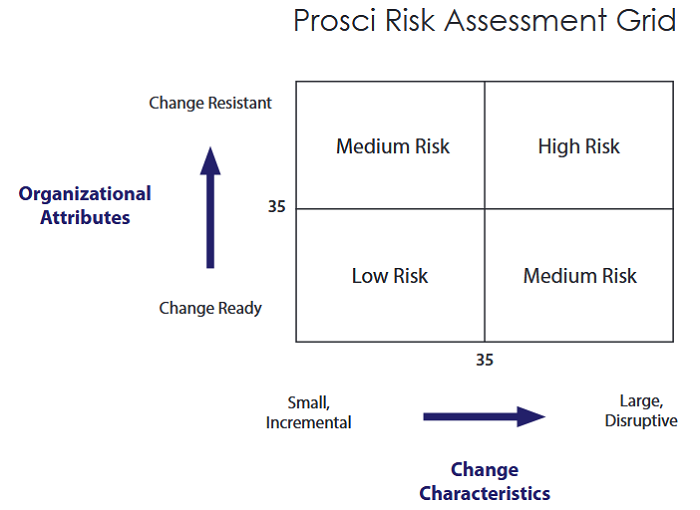Technique 1.138 Prosci Risk Assessment
Introduction
It is a way of assessing change and organisational readiness

Assessment
Rank each statement from 1 to 5; the higher the score, the more likely resistance will be a problem.
1. Scope of change
| Working group Department Division Enterprise |
2. Number of impacted employees
3. Variations in groups that are impacted
| All groups impacted the same Groups experiencing the change differently |
4. Type of change
| Singular aspect, simple change Many aspects, complex change |
5. Degrees of process change
6. Degree of technology and system change
7. Degree of job roles change
8. Degree of organisational restructuring
9. Amount of change overall
| Incremental change Radical change |
10. Impact on employee compensation
| No impact on pay or benefits Large impact on pay or benefits |
11. Reduction in total staffing levels
No change expected Significant change expected
|
12. Timeframe for change
Very short (< month) or very long (> year) 3 to 12 month initiative
|
13. Perceived need for change among employees and managers
Compelling business need for change is visible Employees do not view change as necessary
- employees are dissatisfied with the current state - employees are satisfied with the current state |
14. Impact of past changes on employees
Employees perceive the past Employees perceive past
change as positive change as negative |
15. Change capacity
Very few changes underway Everything is changing
|
16. Past changes
Changes were successful Many failed projects and changes
and well-managed were poorly managed |
17. Shared vision and direction for the organisation
Widely shared and Many different directions
unifying vision and shifting priorities |
18. Resources and funding available
Adequate resources and Resources and funds
funds are available are limited |
19. Organisational culture's responsiveness to change
Open and receptive Closed and resistant to
the new ideas and change new ideas on change
|
20. Organisational reinforcement
Employees are rewarded for risk-taking Employees are rewarded for
and embracing change consistency and predictability |
21. Leadership style and power distribution
Centralised Decentralised/distributed
|
22. Executive/senior manager's change competency
Managers are highly competent Managers lacked the knowledge and
at managing change skills for managing change |
23. Middle management change competency
Managers are highly competent Managers lacked the knowledge and handling change skills for handling change
|
24. Employee change competency
Employees are highly competent Employees lack the knowledge and
at handling change skills for handling change |
Add up your score; a score of 35 or more indicates a high level of resistance.
(source: Prosci, 2023s)

